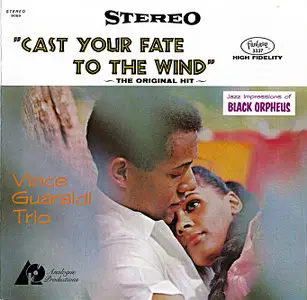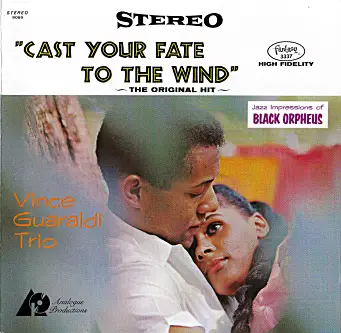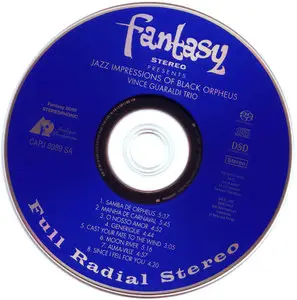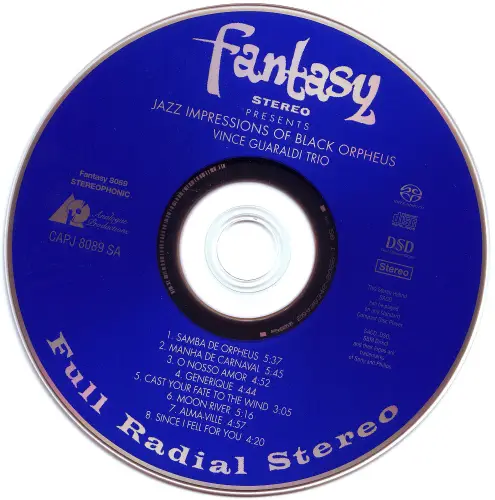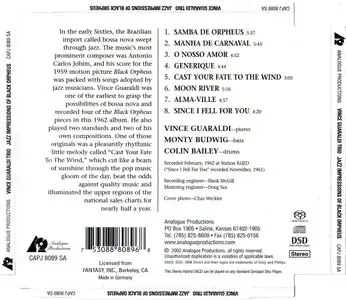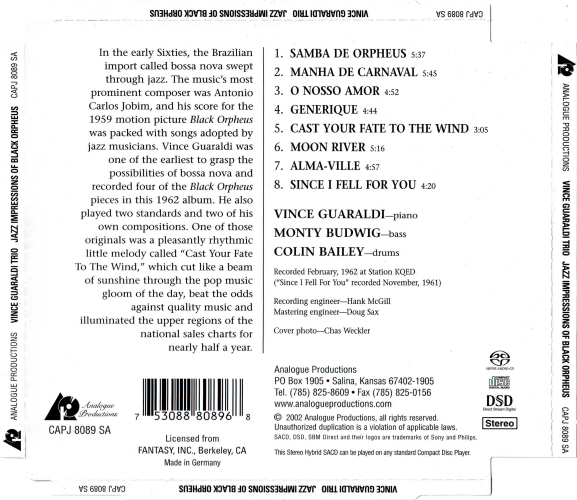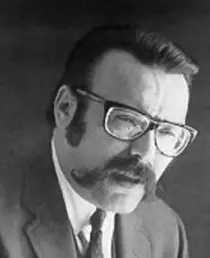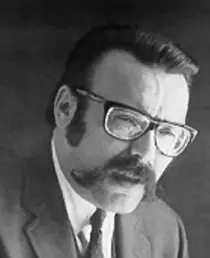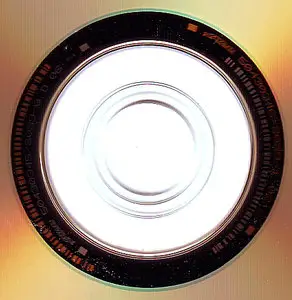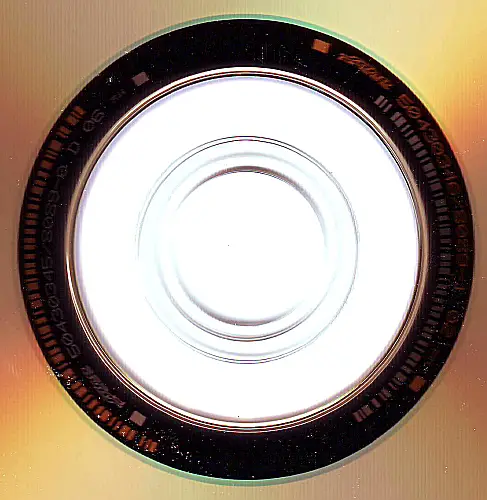Vince Guaraldi Trio - Jazz Impressions of Black Orpheus (2002) {Analogue Productions}
Jazz | EAC Rip | FLAC (tracks)+CUE+LOG | mp3@320 | 249 MB. & 113 MB.
300dpi. Complete Scans (JPG) included | WinRar, 3% recovery
Audio CD (2002) | Label: Fantasy/Analogue Productions | Catalog# CAPJ-8089-SA | 39:14 min.
Jazz | EAC Rip | FLAC (tracks)+CUE+LOG | mp3@320 | 249 MB. & 113 MB.
300dpi. Complete Scans (JPG) included | WinRar, 3% recovery
Audio CD (2002) | Label: Fantasy/Analogue Productions | Catalog# CAPJ-8089-SA | 39:14 min.
Review by Richard S. Ginell ~allmusic.com
Here is Vince Guaraldi’s breakthrough album — musically, commercially, in every which way. After numerous records as a leader or sideman, for the first time a recognizable Guaraldi piano style emerges, with whimsical phrasing all his own, a madly swinging right hand and occasional boogie-influenced left hand, and a distinctive, throat-catching, melodic improvisational gift. The first half of the program is taken up by cover versions of tunes from the Antonio Carlos Jobim/Luiz Bonfa score for the film Black Orpheus, recorded just as bossa nova was taking hold in America. These are genuinely jazz-oriented impressions in a mainstream boppish manner, with only a breath of samba from Monty Budwig (bass) and Colin Bailey (drums) in the opening minute of “Samba de Orpheus”; an edited version of this haunting song was issued as a 45 rpm single. But DJs soon began flipping the single over to play the B-side, a wistful, unforgettably catchy Guaraldi tune called “Cast Your Fate to the Wind” that opens the North American half of the album. The tune became a surprise hit; Fantasy redesigned the cover to call attention to it, and Vince was on his way to fame as one of Latin and mainstream jazz’s most irresistible composers. The whole album evokes the ambience of San Francisco’s jazz life in the 1960s as few others do — and such is this record’s appeal that even non-jazz and non-Latin music people have been grooving to this music ever since it came out.
Tracklist:
01. Samba de Orpheus (5:43)
02. Manha de Carnaval (5:51)
03. O Nosso Amor (4:57)
04. Generique (4:48)
05. Cast Your Fate to the Wind (3:10)
06. Moon River (5:22)
07. Alma-Ville (5:01)
08. Since I Fell for You (4:23)
Personnel:
Vince Guaraldi – piano
Monty Budwig – bass
Colin Bailey – drums
Born: July 17, 1928 | Died: February 6, 1976 | Instrument: Piano
By Derrick Bang ~allAboutJazz
Like most so-called overnight successes, Vincent Anthony Guaraldi–who forever described himself as “a reformed boogie-woogie piano player”–worked hard for his big break.
The man eventually dubbed “Dr. Funk” by his compatriots was born in San Francisco on July 17, 1928; he graduated from Lincoln High School and then San Francisco State College. Guaraldi began performing while in college, haunting sessions at the Black Hawk and Jackson's Nook, sometimes with the Chubby Jackson / Bill Harris band, other times in combos with Sonny Criss and Bill Harris. He played weddings, high school concerts, and countless other small-potatoes gigs.
His first serious booking came at the Black Hawk, when he worked as an intermission pianist … filling in for the legendary Art Tatum. “It was more than scary”, Guaraldi later recalled. “I came close to giving up the instrument, and I wouldn't have been the first after working with Tatum”. Guaraldi's first recorded work can be heard on “Vibratharpe”, a 1953 release by the Cal Tjader Trio. Guaraldi then avoided studios for the next few years, preferring to further hone his talents in the often unforgiving atmosphere of San Francisco's beatnik club scene. In 1955 he put together his own trio – longtime friend Eddie Duran on guitar, Dean Reilly on bass – and tackled North Beach's bohemian hungry i club. He also returned to studio work that year, making his recorded debut as group leader, although with different personnel: John Markham (drums), Eugene Wright (bass) and Jerry Dodgion (alto sax). What soon came to be recognized as the “Guaraldi sound”, however, resulted from several recording sessions with his hungry i buddies. The original Vince Guaraldi Trio, with Duran
and Reilly, can be heard on two releases: “The Vince Guaraldi Trio” (1956) and “A Flower is a Lonesome Thing” (1957)
The late 50s were a busy time. Aside from studio sessions with Conte Candoli (two albums), Frank Rosolino (one album), and Cal Tjader (at least ten albums), Guaraldi toured in 1956 with Woody Herman's third “Thundering Herd”, replacing Nat Pierce on piano for one season. Not too much later, just after midnight during 1958's first annual Monterey Jazz Festival, some 6,000 rabid but by now quite tired jazz fans came to their feet when The Cal Tjader Quintet blew them away.
Thanks in no small part to the “sound of surprise” from the feisty Guaraldi, whose extended blues riffs literally had the crowd screaming for more, Tjader's quintet received an enthusiastic standing ovation.
National prominence was just around the corner. Inspired by the 1959 French/Portuguese film “Black Orpheus”, Guaraldi hit the studio with a new trio – Monte Budwig on bass, Colin Bailey on drums – and recorded his own interpretations of Antonio Carlos Jobim's haunting soundtrack music. The 1962 album was called “Jazz Impression of Black Orpheus”, and “Samba de Orpheus” was the first selection released as a single. Combing the album for a suitable B-side number, Guaraldi's producers finally ghettoized a modest original composition titled “Cast Your Fate to the Wind”.
Fortunately, some enterprising Sacramento, California DJs turned the single over…
…and the rest is history.
“Cast Your Fate to the Wind” became a Gold Record winner and earned the 1963 Grammy as Best Instrumental Jazz Composition. It was constantly demanded during Guaraldi's club engagements, and suddenly jazz fans couldn't get enough of him. He responded with several albums during 1963 and '64, perhaps the most important of which was “Vince Guaraldi, Bola Sete, and Friends”, with Fred Marshall (bass), Jerry Granelli (drums) and Brazilian guitarist Bola Sete. That marked the first of several collaborations with Sete, a musical collaboration whose whole was greater than the sum of its already quite talented parts.
Guaraldi was also a recognized fixture on television, if only in the greater San Francisco region. He and jazz critic Ralph Gleason documented the success of “Cast Your Fate to the Wind” in the three-part “Anatomy of a Hit”, produced for San Francisco's KQED; later, shortly after his first album with Sete, Guaraldi did a “Jazz Casual” TV show for the same network
The most prestigious task, however, was yet to come. Even before Duke Ellington played San Francisco's Grace Cathedral, that venerable institution's Reverend Charles Gompertz selected Guaraldi to write a modern jazz setting for the choral Eucharist. The composer labored18 months with his trio and a 68-voice choir, and the result is an impressive blend of Latin influences, waltz tempos, and traditional jazz “supper music”. It was performed live on May 21, 1965, and the album became another popular and critical hit. Clearly, if Vince Guaraldi could write music for God, he could pen tunes for Charlie Brown.
The jazz pianist's association with Charles Schulz's creations actually had begun the year before, when Guaraldi was hired to score the first Peanuts television special, adocumentary called “A Boy Named Charlie Brown” (not to be confused with the big-screen feature of the same title). The show brought together four remarkable talents: Schulz, writer/producer/director Lee Mendelson, artist Bill Melendez and Guaraldi.
Guaraldi's smooth trio compositions – piano, bass and drums – perfectly balanced Charlie Brown's kid-sized universe. Sprightly, puckish, and just as swiftly somber and poignant, these gentle jazz riffs established musical trademarks which, to this day, still prompt smiles of recognition.
They reflected the whimsical personality of a man affectionately known as a “pixie”, an image Guaraldi did not discourage. He'd wear funny hats, wild mustaches, and display hairstyles from buzzed crewcuts to rock-star shags.
Unfortunately, with an irony that seemed appropriate for a documentary about Charlie Brown, Mendelson never was able to sell the show, which remains unseen to this day by the general public. Fortunately, the unaired program became an expensive calling-card that attracted a sponsor (Coca-Cola) intrigued by the notion of a Peanuts Christmas TV special. Thus, when “A Charlie Brown Christmas” debuted in December 1965, it did more than reunite Schulz, Mendelson, Melendez and Guaraldi, all of whom quickly turned the Peanuts franchise into a television institution. That first special also shot Guaraldi to greater fame, and he became irreplaceably welded to all subsequent Peanuts shows. Many of his earliest Peanuts tunes – “Linus and Lucy”, “Red Baron” and “Great Pumpkin Waltz”, among others – became signature themes that turned up in later specials.
Guaraldi became so busy that the ensuing decade saw only half a dozen album releases, three of them direct results of his Peanuts work: “A Boy Named Charlie Brown”, “A Charlie Brown Christmas” and “Oh, Good Grief!” At some point between his switch from the Fantasy label to Warner Brothers, Guaraldi took the time to produce and direct an album that has become quite obscure: 1968's “Vince Guaraldi with the San Francisco Boys Chorus”, released on his own D&D label. This was followed by two Warners releases: “The Eclectic Vince Guaraldi”, which marks Guaraldi's recorded vocal debut; and “Alma-Ville”, which showcases a Guaraldi guitar solo on one cut. On February 6, 1976, while waiting in a motel room between sets at Menlo Park's Butterfield's nightclub, Guaraldi died of a sudden heart-attack. He was only 47 years old.
A few weeks later, on March 16, “It's Arbor Day, Charlie Brown” debuted on television. It was the 15th, and last, Peanuts television special to boast Guaraldi's original music. He had just finished recording his portion of the soundtrack on the very afternoon of the day he died.
Time … passed.
Those who followed in Guaraldi's Peanuts-themed footsteps – Ed Bogas, Desiree Goyette, Judy Munsen and others – found the shoes impossible to fill. Not one produced a song or theme anywhere near as catchy as the Master, and several of the specials from the late 1970s and '80s consequently lacked a certain zip.
A whopping three decades later, no doubt responding to unceasing pleas from fans who had played Guaraldi's three Peanuts albums to death – and wondered what had become of the themes and background music in all those other television specials – Fantasy released 1998's “Charlie Brown's Holiday Hits”. The CD included nine previously unissued tracks, from the theme to “A Charlie Brown Thanksgiving” to a vocal rendition of “Oh, Good Grief”, performed by Lee Mendelson's son's sixth-grade class.Four years later, in the summer of 2003, Vince Guaraldi's son, David, teamed up with Bluebird Records to release “The Charlie Brown Suite”. The centerpiece selection, long spoken of in reverential tones by fans who only knew of it but never had heard it, is the fully orchestrated “Charlie Brown Suite”, recorded live on May 18, 1969, during a benefit performance with Amici Della Musica (Richard Williams, conductor) at Mr. D's, a theater/restaurant in San Francisco's North Beach region. This awesome piece of music clocks in at roughly 40 minutes and skillfully weaves half a dozen songs into an integrated whole: “Linus and Lucy”, “The Great Pumpkin Waltz”, “Peppermint Patty”, “Oh, Good Grief”, “Rain, Rain, Go Away” and “Red Baron”.
Encouraged by the enthusiastic response to this new compilation of his father's previously unreleased recordings, David Guaraldi has big plans for the upcoming years … and this Web site is the place to get up-to-the-minute information.
“I don't think I'm a great piano player”, Vince Guaraldi once said, “but I would like to have people like me, to play pretty tunes and reach the audience. And I hope some of those tunes will become standards. I want to write standards, not just hits”. He got his wish.
Windham Hill recording artist George Winston has been playing “Linus and Lucy” for years, during his concert appearances. A promise to record it and other Guaraldi cuts finally bore fruit in the autumn of 1996, with the release of Winston's “Linus & Lucy: TheMusic of Vince Guaraldi”.
“Linus and Lucy” also has been interpreted by Wynton Marsalis, Dave Brubeck and David Benoit; the latter has become Guaraldi's ongoing torch-bearer in the most recent Peanuts animated TV specials. GRP Records had a smash hit back in 1990, with their soundtrack to the television special “Happy Anniversary Charlie Brown”, which gathered numerous jazz luminaries for their interpretations of classic Guaraldi compositions, along with some new cuts clearly inspired by Dr. Funk's Peanuts themes.
“Christmas Time is Here” has become a seasonal fixture, and pretty much everybody of consequence has covered “Cast Your Fate to the Wind”.
Let's fade with the words of Jon Hendricks, poet laureate of jazz, who once wrote:
“Vince is what you call a piano player. That's different from a pianist. A pianist can play anything you can put in front of him. A piano player can play anything before you can put it in front of him.”
Vince Guaraldi (1928 - 1976)
Recorded on February, 1962 at Station KQED
(“Since I Fell for You”, recorded on November, 1961)
Recording Engineer: Hank McGill
Mastering Engineer: Doug Sax
Cover photo by Chas Weckler
Cover designed by Balzer/Shopes
Liner notes by Ralph J. Gleason
2002 - Analogue Productions; licenced from Fantasy, Inc., Berkeley, CA
EAC extraction logfile from 15. December 2007, 20:48 for CD
Vince Guaraldi Trio / Jazz Impressions of Black Orpheus
Used drive : ASUS DRW-1814BL Adapter: 4 ID: 0
Read mode : Secure with NO C2, accurate stream, disable cache
Read offset correction : 6
Overread into Lead-In and Lead-Out : No
Used output format : Internal WAV Routines
44.100 Hz; 16 Bit; Stereo
Other options :
Fill up missing offset samples with silence : Yes
Delete leading and trailing silent blocks : No
Installed external ASPI interface
Range status and errors
Selected range
Filename C:\Documents and Settings\Master\Desktop\Äëÿ ğàáîòû ñ ìóçûêîé\Íîâàÿ ïàïêà\Vince Guaraldi Trio - Jazz Impressions of Black Orpheus.wav
Peak level 100.0 %
Range quality 100.0 %
CRC F39ACC9C
Copy OK
No errors occured
End of status report
Vince Guaraldi Trio / Jazz Impressions of Black Orpheus
Used drive : ASUS DRW-1814BL Adapter: 4 ID: 0
Read mode : Secure with NO C2, accurate stream, disable cache
Read offset correction : 6
Overread into Lead-In and Lead-Out : No
Used output format : Internal WAV Routines
44.100 Hz; 16 Bit; Stereo
Other options :
Fill up missing offset samples with silence : Yes
Delete leading and trailing silent blocks : No
Installed external ASPI interface
Range status and errors
Selected range
Filename C:\Documents and Settings\Master\Desktop\Äëÿ ğàáîòû ñ ìóçûêîé\Íîâàÿ ïàïêà\Vince Guaraldi Trio - Jazz Impressions of Black Orpheus.wav
Peak level 100.0 %
Range quality 100.0 %
CRC F39ACC9C
Copy OK
No errors occured
End of status report
[CUETools log; Date: 21.06.2011 20:22:14; Version: 2.0.9]
[CTDB TOCID: zYlA8SiSsYvPwYfvvhSaLrN.Ohc-] disk not present in database.
[AccurateRip ID: 000c9954-0052d460-6d093108] found.
Track [ CRC ] Status
01 [e565cacd] (11/11) Accurately ripped
02 [79e91a6c] (11/11) Accurately ripped
03 [2b7e88ae] (11/11) Accurately ripped
04 [3a747a83] (11/11) Accurately ripped
05 [4ced4cf1] (11/11) Accurately ripped
06 [094250fd] (11/11) Accurately ripped
07 [61f48512] (11/11) Accurately ripped
08 [1efd1cfb] (11/11) Accurately ripped
Track Peak [ CRC32 ] [W/O NULL]
– 100,0 [F39ACC9C] [385E80E5]
01 100,0 [753F2674] [AD8A147D]
02 94,6 [06864AFA] [E033073B]
03 90,6 [B4E50469] [90309898]
04 91,8 [0ADB7F78] [C5C34E84]
05 100,0 [177C99ED] [8CEBA091]
06 77,7 [39E7E2E0] [620E208F]
07 100,0 [63586C68] [70290CE5]
08 100,0 [6CDFBBAE] [E0EB8660]
[CTDB TOCID: zYlA8SiSsYvPwYfvvhSaLrN.Ohc-] disk not present in database.
[AccurateRip ID: 000c9954-0052d460-6d093108] found.
Track [ CRC ] Status
01 [e565cacd] (11/11) Accurately ripped
02 [79e91a6c] (11/11) Accurately ripped
03 [2b7e88ae] (11/11) Accurately ripped
04 [3a747a83] (11/11) Accurately ripped
05 [4ced4cf1] (11/11) Accurately ripped
06 [094250fd] (11/11) Accurately ripped
07 [61f48512] (11/11) Accurately ripped
08 [1efd1cfb] (11/11) Accurately ripped
Track Peak [ CRC32 ] [W/O NULL]
– 100,0 [F39ACC9C] [385E80E5]
01 100,0 [753F2674] [AD8A147D]
02 94,6 [06864AFA] [E033073B]
03 90,6 [B4E50469] [90309898]
04 91,8 [0ADB7F78] [C5C34E84]
05 100,0 [177C99ED] [8CEBA091]
06 77,7 [39E7E2E0] [620E208F]
07 100,0 [63586C68] [70290CE5]
08 100,0 [6CDFBBAE] [E0EB8660]
Thanks to the original releaser.
(flac links are interchangeable, mp3@320 = single link)


